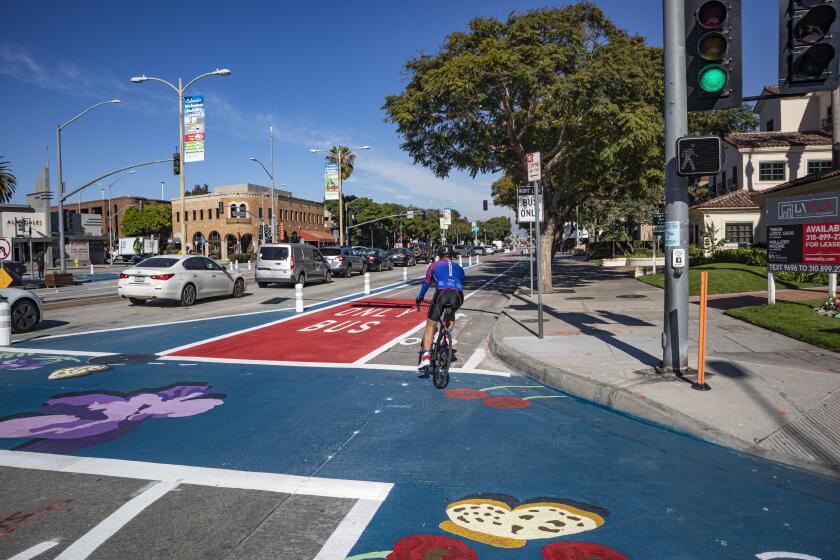Opinion: One simple rule could save the birds that migrate over L.A.

- Share via
As night falls, look up. At this time of year, tens of thousands of birds make their way across Los Angeles, navigating by starlight and Earth’s magnetic fields to breeding grounds along the West Coast. Though cloaked in darkness while they pass L.A., these birds are of every color of the rainbow, rivaling even the most vibrant superblooms.
But not all of these avian voyagers will find safe passage. In the U.S. every year, hundreds of millions of birds die after colliding into buildings — often during migration. Our city should be part of the solution.
Building collisions usually occur when birds crash into windows. Birds do not perceive clear panes of glass as obstacles but, rather, as empty space through which they can fly. Daytime is hazardous because windows sometimes reflect the sky or nearby trees, adding to birds’ confusion. Nights are dangerous because nocturnally migrating birds are attracted to lights, drawing them toward cities.
Los Angeles leaders can take action to make our city safer for birds. One key step is to require the use of bird-safe glass, which is designed to obscure windows’ reflections. This helps birds recognize windows as obstacles and minimizes collisions. Bird-safe glass can be opaque, frosted or clear — with an etched design or external covering, such as film or decals.
In December, the Los Angeles City Planning Commission approved a wildlife ordinance that would require all new buildings and significant remodels within a proposed wildlife district in the Santa Monica Mountains to use bird-safe glass. The City Council has not yet voted on this ordinance.
While incorporating bird-safe building policies in the new wildlife district is a laudable first step, the City Council should go further and enact this rule for all new construction and significant remodels throughout Los Angeles.
Bird-safe building ordinances have been implemented across the U.S., from New York to Portland, Ore., and from Chicago to our neighboring Ventura County. San Francisco has championed bird-friendly building codes for over a decade, now codified in the city’s Standards for Bird Safe Buildings. Nine other cities in the Bay Area have followed suit, passing local legislation to mandate the use of bird-safe glass. Los Angeles’ adoption of bird-safe building standards would put the city in line with neighboring regions and strengthen our commitment to biodiversity initiatives in California.
But even before the City Council votes on the wildlife ordinance, Angelenos can take other actions to help prevent bird collisions:
- Treat the windows in your home to make them safe for birds. DIY window coverings, including decals, tape, tempera paint and one-way transparent film, help boost visibility and mitigate collisions with glass. Insect screens double as mosquito protection and bird-safe window treatments. If you’re building a new home or remodeling, consider choosing bird-safe glass from the start.
- Turn off your indoor lights when you’re not using them. If you’re updating your landscaping, consider using shielded outdoor lighting fixtures, which help minimize the light pollution that confuses birds.
- Monitor for collisions to help scientists understand where and how often they are happening. If you find a bird that died from impact with a window, add your observation to dBird.org or the Global Bird Collision Mapper and report your sighting to the Natural History Museum of Los Angeles County by sending an email to [email protected].
- Contact your City Council representative and encourage them to pass the wildlife ordinance and draft a citywide bird-safe building policy.
A few simple steps can help ensure safe passage for the millions of birds that migrate through the night skies of the City of Angels.
Olivia Sanderfoot is a postdoctoral scholar in ecology at UCLA. Madeleine Siegel is a doctoral researcher in environmental science and policy at UCLA. Hayley Spina is a doctoral candidate at the University of Guelph in Canada.
More to Read
A cure for the common opinion
Get thought-provoking perspectives with our weekly newsletter.
You may occasionally receive promotional content from the Los Angeles Times.










